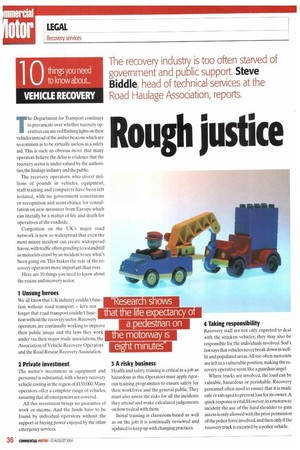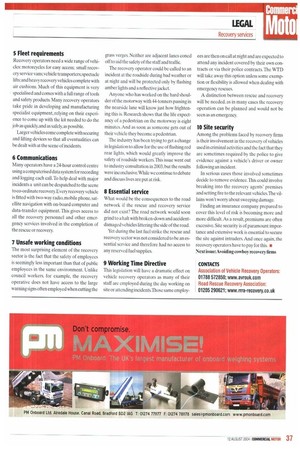Rough justice
Page 36

Page 37

If you've noticed an error in this article please click here to report it so we can fix it.
The Department for Transport continues to prevaricate over whether recovery operatives can use red flashing lights on their vehicles instead of the amber beacons which are so common as to be virtually useless as a safety aid. This is such an obvious move that many operators believe the delay is evidence that the recovery sector is under-valued by the authorities,the haulage industry and the public.
The recovery operators, who invest millions of pounds in vehicles, equipment, staff training and computers have been left isolated, with no government concessions or recognition and scant chance for consultation on new measures from Europe which can literally be a matter of life and death for operatives at the roadside.
Congestion on the UK's major road network is now so widespread that even the most minor incident can create widespread havoc, with traffic often grinding to a standstill as motorists crawl by an incident to see what's been going on. This makes the role of the recovery operators more important than ever.
Here are 10 things you need to know about the rescue and recovery sector.
1 Unsung heroes
We all know that UK industry couldn't function without road transport — let's not forget that road transport couldn't function without the recovery sector. Recovery operators are continually working to improve their public image and the laws they work under via their major trade associations. the Association of Vehicle Recovery Operators and the Road Rescue Recovery Association.
2 Private investment
The sector's investment in equipment and personnel is substantial, with a heavy recovery vehicle costing in the region of £150,000. Many operators offer a complete range of vehicles, ensuring that all emergencies are covered.
All this investment brings no guarantee of work or income. And the funds have to be found by individual operators without the support or buying power enjoyed by the other emergency services.
3 A risky business
Health and safety training is critical in a job as hazardous as this. Operators must apply rigorous training programmes to ensure safety for their workforce and the general public. They must also assess the risks for all the incidents they attend and make calculated judgements on how to deal with them.
Initial training is classroom-based as well as on the job; it is continually reviewed and updated to keep up with changing practices.
4 Taking responsibility
Recovery staff are not only expected to deal with the stricken vehicles; they may also be responsible for the individuals involved. Sod's law says that vehicles never break down in welllit and populated areas. All too often motorists are left in a vulnerable position, making the recovery operative seem like a guardian angel.
Where trucks are involved, the load can be valuable, hazardous or perishable. Recovery personnel often need to ensure that it is made safe or salvaged to prevent loss for its owner.A quick response is vital. However, in a motorway incident the use of the hard shoulder to gain access is only allowed with the prior permission of the police force involved, and then only if the recovery truck is escorted by a police vehicle.
5 Fleet requirements
Recovery operators need a wide range of vehicles: motorcycles for easy access; small recovery service vans; vehicle transporters; spectacle lifts; and heavy recovery vehicles complete with air cushions. Much of this equipment is very specialised and comes with a full range of tools and safety products. Many recovery operators take pride in developing and manufacturing specialist equipment, relying on their experience to come up with the kit needed to do the job as quickly, and as safely, as possible.
Larger vehicles come complete with securing and lifting devices so that all eventualities can be dealt with at the scene of incidents.
6 Communications
Many operators have a 24-hour control centre using a computerised data system for recording and logging each call. To help deal with major incidents a unit can be despatched to the scene to co-ordinate recovery. Every recovery vehicle is fitted with two-way radio, mobile phone. satellite navigation with on-board computer and data-transfer equipment. This gives access to all the recovery personnel and other emergency services involved in the completion of the rescue or recovery.
7 Unsafe working conditions
The most surprising element of the recovery sector is the fact that the safety of employees is seemingly less important than that of public employees in the same environment. Unlike council workers, for example, the recovery operative does not have access to the large warning signs often employed when cutting the grass verges. Neither are adjacent lanes coned off to aid the safety of the staff and traffic.
The recovery operator could be called to an incident at the roadside during bad weather or at night and will be protected only by flashing amber lights and a reflective jacket.
Anyone who has worked on the hard shoulder of the motorway with 44-tonners passing in the nearside lane will know just how frightening this is. Research shows that the life expectancy of a pedestrian on the motorway is eight minutes. And as soon as someone gets out of their vehicle they become a pedestrian.
The industry has been trying to get a change in legislation to allow for the use of flashing red rear lights, which would greatly improve the safety of roadside workers. This issue went out to industry consultation in 2003, but the results were inconclusive.While we continue to debate and discuss lives are put at risk.
8 Essential service
What would be the consequences to the road network if the rescue and recovery service did not exist? The road network would soon grind to a halt with broken-down and accidentdamaged vehicles littering the side of the road.
Yet during the last fuel strike the rescue and recovery sector was not considered to be an essential service and therefore had no access to any reserved fuel supplies.
9 Working Time Directive
This legislation will have a dramatic effect on vehicle recovery operators as many of their staff are employed during the day working on site or attending incidents.Those same employ ees are then on call at night and are expected to attend any incident covered by their own contracts or via their police contracts. The WTD will take away this option unless some exemption or flexibility is allowed when dealing with emergency rescues.
A distinction between rescue and recovery will be needed, as in many cases the recovery operation can be planned and would not be seen as an emergency.
10 Site security
Among the problems faced by recovery firms is their involvement in the recovery of vehicles used in criminal activities and the fact that they are sometimes required by the police to give evidence against a vehicle's driver or owner following an incident.
In serious cases those involved sometimes decide to remove evidence. This could involve breaking into the recovery agents' premises and setting fire to the relevant vehicles.The villains won't worry about sweeping damage.
Finding an insurance company prepared to cover this level of risk is becoming more and more difficult. As a result, premiums are often excessive. Site security is of paramount importance and extensive work is essential to secure the site against intruders. And once again, the recovery operators have to pay for this. • Next issue: Avoiding cowboy recovery firms CONTACTS Association of Vehicle Recovery Operators: 01788 572850; www.avrouk.com Road Rescue Recovery Association: 01205 290621; vinuw.rrra-recovery.co.uk
























































































































































































